#even if the medium of choice for doing that is hand picking and resurrecting old OCs and shipping them with some of my said faves *shrug*
Text
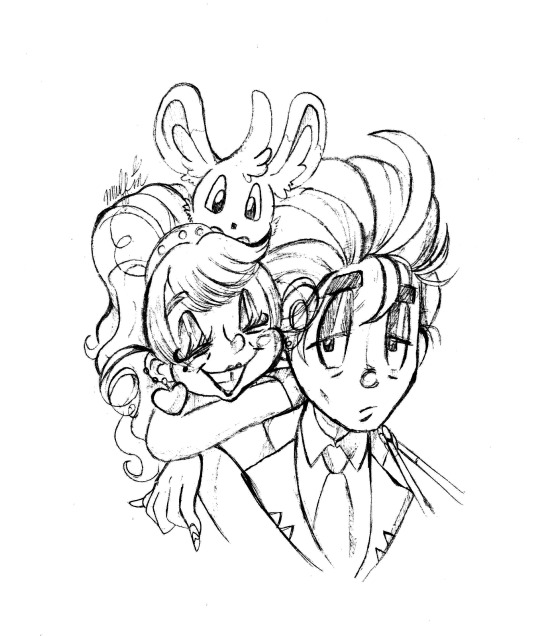
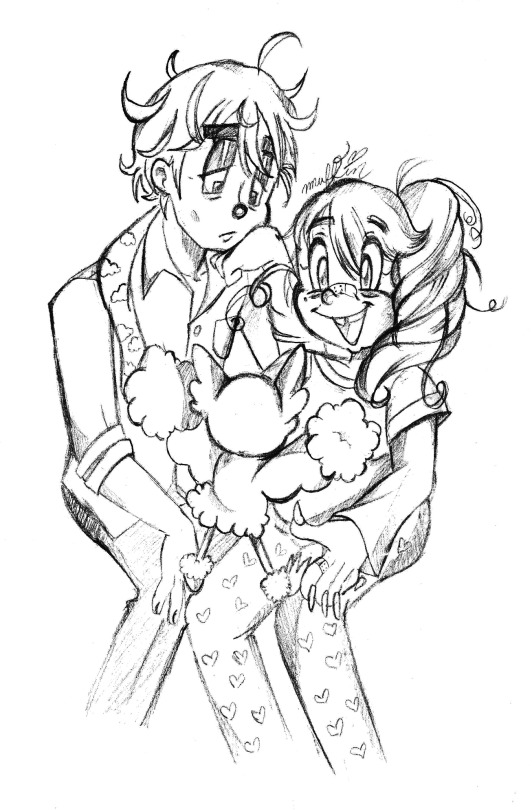



best friend he never asked for. well, he's stuck with her whether he likes it or not. good luck to them both.
#larry pokemon#pokemon larry#gym leader larry#oc x canon#pokemon oc x canon#pkmn sv#OC fifi#yeah. these are gonna go in some of his tags i'm sorry#their dynamic is 'middle aged ppl who don't realize they're both neurodivergent & ace' & their song is 'being boring' by the pet shop boys#i'm done hiding what i think is cringe!!! i'm old! now let me have fun and analyze my favorite characters (esp ones i relate to!!)#even if the medium of choice for doing that is hand picking and resurrecting old OCs and shipping them with some of my said faves *shrug*#i'm still too much of a pissbaby to write my fics but i will--some day... i wanna take my faves and dissect them they are so interesting#(oc x canon but u project more onto the canon character rather than the OC...)#mine#my art#my ocs
33 notes
·
View notes
Text
NYFF 2020: Part 1

It’s been a curious season of festivals — as always, Venice, TIFF, and the NYFF go more or less back-to-back-to-back, making for an almost indecent amount of captivating offerings for all but the most gluttonous of cinephiles — but not without its charms. In this time of massive uncertainty in the industry, amongst film distributors and theaters particularly, it’s deeply reassuring to know the medium is still capable of powerful statements, exquisite imagery, and haunting performances as it ever has.
Mind you, next year at this time, if there’s still no widely available vaccine, there might be a more serious dearth of selections, but for what has been an unsettling and mostly miserable 2020, we can thank the stars that films are often shot a year or more in advance of their release.
This year’s NYFF (still ongoing, as I write this) has provided some glories and some failures, more or less in keeping with the usual standard. Herewith, a quartet of selections, ranging from a resurrected Hungarian triumph, to a modern French non-romance, to the debut of a new and energizing auteur.
Damnation (1988)
Dir. Bela Tarr
Perhaps no setting in cinematic history is more appropriate for shooting in low-contrast black and white than late ‘80s, post-communist Hungary. Bleak, drab, and pelting with rain, the landscape bleeds in shades of grey. Bela Tarr’s 1988 film, a newly restored 4K edition from the Festival’s “Revival” section, begins with a long shot of a ski lift-like apparatus, endlessly transporting buckets of coal to a repository, whose grinding machinery offers a looping hum throughout the film. Much as Tarr’s various musical interludes include similarly cyclical drones of accordion music, are the men and women of this nameless small city seemingly doomed to their various loops of behavior and experience. In Tarr’s Hungary, everyone looks haunted and morose, like a selection of down-on-their-luck rummies in a dive bar at last call. One such bar patron, Karrer (Miklos Szekely B.), is deeply in love with a beautiful, depressed (unnamed) nightclub singer (Vali Kerekes), married to a loutish man, Sebestyén (Gyorgy Cserthalmi), in bad debt to the wrong sorts of people. When Karrer’s friend, bar owner Willarsky (Gyula Pauer), offers him a potentially lucrative gig picking up a mystery package abroad and bringing it back to him, Karrer instead offers it to Sebestyén as a means of getting him out of debt, but more importantly getting him away from his wife, so their affair can continue apace. Tarr’s films move slowly, with long, static shots, or slow-panning camera movement, but within his frame, he packs in detail — from the pellet-like surface of a wall, to the expression of a group of people huddled under a station roof, staring out at the endless rain — and adds in acute sound effects as further punctuation (the sound of a man close shaving over his scruff with a straight-edge, for example, or water dripping from an unseen leak). As with his 1994 opus, Satantango, he includes extended shots of drunken merriment, with people dancing, stumbling, falling over each other, and coming back again, but the effect isn’t exactly heartening. As packs of stray dogs work their way over muddy, mostly deserted fields, and Karrer continues to imbibe the depressed resignation of his life’s trajectory (“the fog settles into your soul,” Willarsky helpfully explains), Tarr’s film, his first collaboration with Hungarian novelist László Krasznahorkai, presents a remarkably tactile vision of life under a blundering political machine, well past the point of repair. With its deep shadows, and obvious femme fatale, you could make the case that the film is a ripened Noir, but one with much of the magistry beaten out of it, tarnished in the mud of the fields. Karrer wears a trenchcoat, alright, but it’s only there to keep out the rain.
Mangrove (2020)
Dir. Steve McQueen
Frank Crichlow (Shaun Parkes) didn’t mean to create a community, exactly, when he opened his restaurant in the section of West London that had become home to many immigrants from Trinidad and Jamaica. He just wanted to have a clean business that wouldn’t attract undue police attention, as his former nightclub, Rio, had done. As more and more natives of the Caribbean moved abroad, however, there became a greater need for a place where the community could gather and feel at home. Frank’s place became a local landmark, and Frank himself, a reluctant leader of the growing movement against the continual police harassment many of the residents faced on a daily basis. In this, he wasn’t given much of a choice: Led by a deeply racist police force — more or less personified by writer/director Steve McQueen in the form of the sneering PC Frank Pulley (Sam Spruell) — Frank’s place had been unnecessarily raided nine times in six weeks. So, when approached by local Black activists, including Darcus Howe (Malachi Kirby) and Altheia Jones-Lecointe (Letitia Wright), he agrees to take part in a peaceful protest against the constables. Naturally, the police turn violent, and in the resulting chaos, nine protestors, including Frank, Darcus, and Altheia are arrested. Over time, they are tried, acquitted, and re-tried for even more serious charges. McQueen’s film, another segment from Small Axe, his chronicle of London’s West-Indies neighborhood through the decades, focuses on this specific case, not just because two of the defendants decided to represent themselves (proving to be adept barristers), but because it became a landmark part of the British crusade for civil rights (even though, as the film’s postscript explains, Frank was still routinely harassed by the police for another 18 years after the trial). To capture the sense of the complexity of the community, McQueen employs a David Simon-esque narrative hodge-podge of smaller scenes from different characters’ vantage points and views, allowing us an in-depth sense of the neighborhood and the stakes, while rarely dipping into the more played out elements of the courtroom genre. I would say, in light of the recent racial protests after the Louisville grand jury failed to hold two of the three officers involved in the death of Breonna Taylor responsible, the film could not be more prescient, but, sadly, this would have also been true just about anytime in the last three decades. As Frank says of the incorrigibly racist leaders and henchpeople continually holding them down, “These people are like vampires, you think you beat them, but they keep coming back again.”
The Salt of Tears (2020)
Dir. Philippe Garrel
From the flinch-inducing title (a direct translation from the French), which sounds like a YA novel steeped in melodrama, to the mournful piano soundtrack of the intro, Philippe Garrel’s (very) French counter-romance would seem to indicate a different sort of film than what he’s actually made. It’s a bit of flim-flammery from a celebrated director unafraid to throw his audience for a loop or two (take that title, which proves to be thoroughly ironic until the very last scene). Luc (Logann Antoufermo), a young man from the provinces, has come to Paris to take an entrance exam at an exacting wood-working institute in order to receive a degree in joining, in order to better emulate his woodworking father (Andre Wilms), a kind, elderly man with a “poet’s soul.” In Paris, he happens to meet Djemila (Oulaya Amamra), a sweet young woman falling hard for the handsome Luc, who callously breaks her heart after he returns to his village. Back home, he takes up with Genevieve (Louise Chevillote), an old high-school flame, who also falls deeply for him, getting pregnant in the process, but when he unexpectedly gets accepted to the woodworking school, he dumps her to return to Paris, where — you guessed it! — he meets up with yet another woman, Betsy (Souheila Yacoub), a stunning brunette whom, we are told via our occasional narrator (Jean Chevalier), is finally “his equal.” Or more so, to be precise, as she takes in a second lover (Martin Mesnier) to their apartment, making the unhappy Luc live as a threesome. Garrel’s charting of Luc’s endless relationship explorations themselves gets tiresome, but the director isn’t much interested in his protagonist’s romantic investments, as he is the callousness of Luc, and the young in general — Luc crushes two loving women; then himself gets crushed; while treating his loving father as yet another irritation from time to time — and the manner in which their decision-making has often not matured enough to include the expansiveness of empathy. They know not what they do, until it’s too late.
Beginning (2020)
Dir. Dea Kulumbegashvili
Georgian director Dea Kulumbegashvili’s debut feature, about a family of Jehovah’s Witnesses working as missionaries in a small village outside Tbilisi, and the abuse they endure at the hands of religious extremists, captivates and bewilders in equal measure. The film begins with a long single shot from inside a “prayer house,” as congregants slowly file in and fill the pews, eventually allowing David (Rati Oneli) to begin his sermon concerning the story of Abraham, willing to sacrifice his beloved son in order to appease God. The shot remains static for so long, building its own rhythm, that it becomes that much more shocking when a side door suddenly opens, and an unseen assailant tosses in a fire bomb, lighting the floor and sending everyone into terrified tumult. Kulumbegashvili’s film is filled with similar striking compositions, long single shots with very little camera movement, the edges of the frame gradually generating increasing levels of apprehension, as the action swirls often out of our visual range. She has a way of filming the opposite of what you expect: Several key conversations between pairs of characters are shot with the focus on the reaction rather than the speaker, and vitally significant scenes are crafted with characters’ backs to us, such that we can’t read their expressions or get our normal bearings. It’s a similar conundrum for the missionaries themselves, especially Yana (Ia Sukhitashvili), David’s dutiful wife, a former actress, who tries to make the best of their difficult situation, even in the face of such violent opposition to her husband’s proselytizing, a job David, ambitious he is, sees as the key to rising up in the Church’s hierarchy. After their prayer house is burned to the ground, David leaves for a few days to meet with the Elders in order to secure funding for its replacement. Into that void, enter a detective (Kakha Kintsurashvili), who appears one night to “talk” with Yana, but ends up intimidating her into a sort of sexual compromise, an event that leaves her strangely unfazed, even, it might be said, oddly curious. From there, things get both more dire, and more peculiar, with Kulumbegashvili’s implacable camera remaining stoically witness to her characters’ increasingly distressing plight. As curious as it can be tonally, she is so in command of her narrative, the film is never less than compelling, even as tragedy becomes something else entirely. By film’s end, true to David’s earlier sermons, it’s clear that at least his most devoted acolyte has taken in the biblical lessons he proffered, for better or worse.
#sweet smell of success#ssos#piers marchant#films#movies#nyff#New York Film Festival 2020#Mangrove#Beginning#The Salt of Tears#damnation
2 notes
·
View notes
Text
Appetence [1/?]
AO3 Link:https://archiveofourown.org/works/20251420/chapters/47997634
Blanket Disclaimer
Summary: Red Robin is investigating the disappearance of a friend and stumbles into a spot of supernatural trouble. He doesn't expect to be saved by Jason Todd, miraculously alive five years after his death and now with the inexplicable ability to commune with the dead. Meanwhile, when Jason returned to Gotham he meant to maintain a low profile and not get involved with Bat business. That was before he found out how hot his Replacement is.
Rating: PG-13 (rating may change later)
JayTimBingo Prompts This Chapter: #cemetery #haunting #relics
Canon-Compliance: Alternate Universe; Jason still died but was not found by Talia when he was resurrected. All other events mostly follow the same chronology as New Earth continuity, with mentions made to events in New 52
Author’s Note(s): My attention span was really terrible today and I couldn't focus on either of my two other fics even though the next chapters of both are completely planned out. So I'm posting the start of the third (and final) story that I'm doing for the JayTimWeek/Month challenge. Also, I'm really excited about this one. I spent more time planning this than either of the other two and I can't wait to hear what you guys think!I've got work stuff to do tomorrow so there may not be anything updated until Friday.
Beta Reader: I’ll get back to you on that.
________________________________________________________________
The Bat-Signal cuts through the dark and hazy clouds lingering above Gotham City, and for a split-second, Jason Todd has the urge to drop everything and race for the roof of the GCPD Headquarters. It’s hard to ignore the nervous jump of excitement in his stomach, the phantom sensation of a domino mask on his face and the heavy drag of a cape at his shoulders.
Which makes no sense, since it’s been at least five years since I even wore that shit.
Taking a drag of his cigarette, the smoke mixing with the familiar summer smog, Jason turns his back on Gotham’s literal beacon of hope and steels himself against nocturnal threats of his own. The city is for the caped crew—because apparently, the Bat has a posse now, he thinks with only a hint of a bitter sneer—and Jason has been fighting in a different arena for quite some time now.
He takes a final drag of the cigarette, and then grinds it beneath his boots, and shoves his hands in the pockets of his leather jacket. It’s a weathered and worn thing that reminds him of one Willis Todd wore in one of the few memories Jason has of him that doesn’t involve alcohol or fists. He thinks it’s less pretentious looking than a trench coat and probably gives off fewer ‘creepy motherfucker’ vibes like the sartorial choices of certain other people. It’s also less likely to snag on things when he needs to make a quick exit while digging up graves.
Yeah, it’s a thing in his line of work.
Gotham Cemetery is a sprawling necropolis, as dark and forbidding now as it was the night he dug himself out of his own grave. Half a decade of Gotham-style tender, loving negligence has left the somber green hills overgrown and the majority of the old tombstones fallen or rotting.
You’d think in a city with the highest homicide rate in the country, the mayor would spring for better maintenance. Then again, it’s Gotham. The dead don’t pay taxes, so fuck ‘em.
Which…enough said.
Gotham and the world think Jason Todd-Wayne is dead and has been for five years now; in a way, it’s the truth. He’s no longer anything like the boy that was beaten to death by a psychotic clown, no longer the shrimp who fastidiously dyed his hair black and jumped into someone else’s cape and pixie boots just so he didn’t have to be his own screwup self anymore. He outgrew wanting to be Dick a long time ago, outgrew wanting to be Bruce, too, and embraced a whole new other set of skills to put him apart from them.
Most occultists and even homo magi need to put conscious effort and intent into calling up or even seeing a spirit. Ever since Jason died and then mysteriously got better, the dead appear to him as blatantly and a solid as the living.
John told him he was a fool to come back here.
“Someone with your gifts, they’ll drive you bloody mad,” his mentor warned him when he left London. “And I ain’t talking about the dead ones, neither.”
“You’re just saying that because Batman wouldn’t hold your hand that one time,” Jason retorted, shrugging off the concern. He is Gotham born and bred, his blood is in those streets, and he has always wanted to come home, even if it wasn’t necessarily to a stately manor or its inhabitants.
He clenches his fists.
Inhabitants that wasted no time in replacing him after he died. Jason was rotting away in fucking Arkham, and Bruce was shoving another kid into the tights.
If it didn’t involve seeing him, I would hunt him down and break his jaw.
He surveys the graveyard proper. The everyday observer considers cemeteries to be places of peace and eternal rest; quiet, if a little bit spooky. To Jason, they’re as gruesome as any major battlefield.
Spirits pack the way before him; some of them look relatively normal if dated by their clothes; many others are disfigured and bloody from whatever killed them, whether natural or unnatural. They clamor and crowd, eternally shouting to be heard, or screaming as they relive their deaths in their own personal purgatories.
In the beginning, that din almost drove Jason insane. Bruce’s teachings kept him rational as long as it could in the months after he woke up, and then John’s training helped him temper his own awareness further. By now, he can function almost normally, automatically filtering the voices out as he goes about his daily business; it’s only in places like this, where the dead outnumber the living, where it’s harder.
Jason reaches up, adjusting the noise filters in his ears—mechanical devices that need regular winding but are still more reliable than anything running on electricity of batteries. They’re like steampunk hearing aids, only instead of magnifying sound, they drown out the constant moan of the ghosts when he can’t do it himself. Just one of many methods of protection he’s learned over the years. Some are physical, like the prayer beads wrapped around his wrist or the bottle of holy water in his pocket; others—spells and symbols and mantras—are carved all over his body in tattoos and blood writing. Anything to keep the otherworld away.
“Personal space is a key to a medium’s sanity,” John told him once. “That and a good bottle of single malt scotch.”
Jason ignores the moss-covered path that winds through the larger and more prominent mausoleums. He deliberately doesn’t search out the one in the distance bearing the Wayne crest—
(Still remembers the feel of his fingernails splitting against the wood of the coffin, choking on clumps of soil and insects.)
—and instead seeks a small structure much farther away. It’s in the furthest part of the cemetery, the shabby section almost hidden by overgrown willows. Half of the name above the doorway is obscured by vines, but it’s easy for him to make out the name etched into the stone with bold letters.
HAYWOOD.
According to the public record, Sheila Haywood’s body was returned to Gotham at the same time as Jason Todd’s. Bruce paid for her funeral and internment, which was just as well since she had no other family, and then she was promptly forgotten about.
By everyone except Jason, it seems.
It took some doing and a few weeks tracking down everyone that had worked at the same refugee camp as his mother, but he’d finally managed to collect what possessions she left behind. A colleague of hers had put them aside when there appeared to be nothing of actual monetary value in them.
A gold coin, small bone carvings of stylized animals, dainty trinkets of garnets, amber and lapis lazuli, a compact mirror, some seashells, a decorative fan, quartz paperweight, and a brightly colored feather. There was a picture of Willis in there, too, young and almost Jason’s double. No picture of Jason, though, but he hadn’t expected it.
He kept the picture but left the rest in the small wooden box, which he now removes from his messenger bag and sets down in front of the stone bearing his mother’s name. He follows that with various tools and ingredients. Black candles arranged in a star shape around the box, a chalice, a jar of detritus—teff seeds, driftwood and soil, all from the place where she died—that he sprinkles around in a circle, a handful of smooth obsidian stones to mark a pentagram joining the candles, the dagger John gave him for his last birthday, vials of oil and holy water.
Murmuring a few protection oaths, he shrugs off his jacket, leaving his arms bare, and then digs out a pack of matches to light the candles; flickering shadows dance across the mausoleum walls. He takes up the chalice to combine the water and oil, and then reaches for the dagger.
Hate this part.
Training to ignore pain doesn’t mean it goes away, and he grits his teeth a little as he draws his blade across his forearm, not deep enough to nick anything vital, but enough that the blood runs easily into the chalice. Without bothering to bandage the wound, Jason holds up the chalice in front of him and centers himself.
“Phantasma inrequietum, te voco,” he intones. “Eloguiorum mei audi: Sheila Haywood, te nominas!“ The stagnant air in the mausoleum starts to pick up. “In nominee creatricis, te impero, hic locum decede.” Hand over the top of the chalice, he swirls the liquid within, and then tips it into the open keepsake box. “Per sanguinem hominis et per sanguinem filii tui, non remane et apage! ”He strikes a match and lobs it into the box, not even flinching as the whole thing flares into flame; he intends to watch it until it burns to nothing.
“That’s not going to work, you know.”
“Jesus fuck!” Jason explodes, whirling to the right and glaring at the interrupter. “What did I say about sneaking up on me? Or just—showing up around me in general?”
The apparition in front of him doesn’t look impressed.
Sheila is still beautiful—or, at least, the side of her body that isn’t covered with third-degree burns and sections of pulverized bone—and still sharp. Cold, untouchable and self-interested.
But unlike the way she was before, she’s all-too present in Jason’s life now.
“Goddamn it,” he snarls, and against every lesson John has ever given him, lashes out and knocks the candles and detritus hard enough to send it skidding across the floor. “What the hell. I’ve done everything. You had last rites, your body was cremated, I just torched the things that had any value to you, why the hell won’t you just move on?”
“You’re asking the wrong questions,” Sheila replies, as always.
Jason scowls. “And of course, you can’t just tell me.”
She gazes at him balefully, and he runs a frustrated hand through his hair.
“Sheila, we’ve been over this. You can’t stay here. One, you know spirits that stick around past their time go Dark Side, and I really don’t want to have to exorcise your spectral ass. Two, it’s fucking creepy for a twenty-year-old guy to be followed around by his mother wherever he goes. What the hell is keeping you here? What more do you want from me?”
“Your forgiveness,” she tells him patiently.
“I already forgave you. Years ago.”
“You still call me Sheila.”
“That’s your name.”
“I’m your mother.”
“Who sold me out and got me murdered.”
“See? You haven’t forgiven me.”
“I have. I’m just stating a fact, Jesus…”
“Apparently the cosmic balance doesn’t agree enough to let me move on,” the ghost says dryly. “And to think, I used to be an atheist.”
“This is total bullshit,” Jason snaps, grabbing his jacket and stalking out of the mausoleum in frustration.
Three years of this mediumship crap, and neither he nor John have ever been able to figure out why the ghost of Jason’s dead mother won’t stop haunting him. Wards and sutras that keep even the nastiest spirits away from Jason don’t even phase her, and she’s inexplicably coherent.
And persistent.
As Jason stalks back through the cemetery, he can sense her in his periphery, gliding along beside him, unconcerned with his irritation.
“Can you just…stay away from me? Like you did in the beginning?” he grumbles.
“You were just learning how to communicate without going insane. I wasn’t about to disrupt that.”
“How considerate of you.”
“I try.”
“Look, I’ve had enough of the ghost-stalker thing for today. I went out of my way for this, you know. I didn’t even want to come back here. And now I’m back to the fucking drawing board.”
“It may not have been a waste of a trip,” she replies and vanishes.
“Oh, you can fuck off when it’s convenient for you,” he grumbles, though he already senses what she was speaking of.
Several yards away, a small boy, maybe eight, is clinging forlornly to an angel headstone. Translucent tears stream down his cheeks, but every now and again his face shifts, like a television caught between two channels, and his mouth widens into an unnatural smile.
Jason could have gone the rest of his life without seeing that smile again.
Still, he sighs and heads toward the kid.
“Hey,” he says, keeping his voice low and maintaining a safe distance from the boy, whose head whips up to stare at Jason in sudden fear.
“Who are you?” he asks, voice thick with tears.
“I’m Jason. You okay, kid?”
“I can’t find my mom,” the boy murmurs, wiping at his face. “I keep going looking, but I forget the way home. And then…I always end up back here.”
He sounds on the verge of tears again; it’s something Jason can understand.
With the puzzling exception of Sheila, who appears to come and go as she pleases, most ghosts are stuck in certain patterns and paths when they die, frozen in an infinite loop until they break themselves out of it or until some arbitrary higher power decides they’ve suffered enough. And for some reason, Jason can break them out of it.
“You could always try again,” he suggests. “I think you’ll manage it this time.”
The boy shudders. “There’s scary people here.”
No arguing with that.
“I know. I see them, too.” Jason glances at the headstone, scanning the name and dates. “Your name’s Cole?”
“Yeah.”
“If you’re missing, there are probably people looking for you. They might have posted something online about it. I’ll check it out, but it could take a bit.” He holds up his phone, glad to see it’s at full charge and bars; that’s hit or miss around so many ghosts. “Can you hang around here until I’m done?”
The boy nods, silent, face flicking back and forth between sadness and the unnatural smile.
Fucking Joker…
Jason does a quick search of the kid’s name, pulling up obituaries in the Gotham Gazette in the past year. It doesn’t take long for an article to pop up concerning the Joker’s latest escape and a list of the dead.
He narrows his eyes, startling the kid.
“It’s fine,” he lies. “The internet is just really slow.”
“Or our phone is really bad,” Cole tells him with the blunt honesty of a kid that grew up constantly surrounded by functional technology.
“Everyone’s a critic…”
Another quick search for the parents, phone lists and social media, and he’s got an address. Crime Alley, of course. He brings it up on his map and enables a view of the street, holding the phone out to the boy. “Is this your house?”
Relief settles and settles over his face. “Yeah.”
“What if I helped you find your way home?”
Cole makes a suspicious face. “I’m not supposed to go anywhere with strangers.”
“Which is really smart. But you see, I’m not really a stranger.”
“Oh yeah? Why not?”
“Well, I’ll let you in on a secret.” Jason bends down, conspiratorial, and Cole’s eyes gleam the way any kid gets when hearing a secret. “When I was a little older than you…I was Robin.”
The boy gapes. “Like…Batman and Robin?”
“Exactly.”
“No way!”
“Way,” Jason smirks, crossing his arms. “And I’ll tell you all about it on the way to your house. Including the time that I stole the wheels off the Batmobile.”
“No way!”
Despite his scandalized disbelief, the kid is obviously hooked.
Jason’s heart clenches a bit at the open curiosity on Cole’s face, the reality hitting him that this boy will never have a chance to do anything mischievous or fun ever again.
From one dead boy to another, this sucks…
As he leads him out of the cemetery, Jason starts to tell the little ghost about his life. He edits out the less pleasant bits, like dying and returning to life half brain dead with the ability to see and hear ghosts.
He figures a good story is the least he can do for the boy.
⁂⁂⁂
Next Chapter
#jaytimweek2019#jaytimweek#jaytim#jaytimbingo2019#fanfic#jaytim fic#jason todd#tim drake#prompt: supernatural#romance#drama#mystery#angst#cemetery#haunting#relics
50 notes
·
View notes
Text
Vintage camera mini review - Argus C3 w/ 50mm f/3.5

There's something special about using old film cameras from days long gone. Maybe it's the thought that the camera being used has real history behind it, having taken untold legions of exposures in the decades since it was assembled, passing hands of maybe two, three generations of users. Or maybe it's the easily traceable evolution of human engineering thought and craft, where each successive decade of camera technology brought with it new tricks, affecting the way it looks, feels, functions as well as the the style, the character, the soul of the camera...
I have owned a number of film cameras from different time periods, always on the lookout for something new to eat through rolls of photosensitive polyester. Araki once said that in order to change your photos, you need to change cameras. I'm a firm believer in this, and lucky for me and other like-minded photographers, there's around a century's worth of different cameras to saddle up and try to tame.
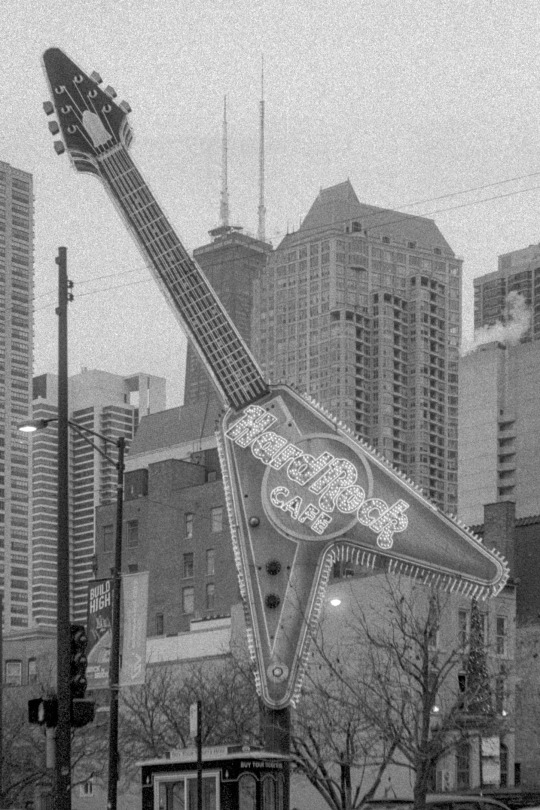
The story
At a friend's party I spied a couple of old cameras, tucked away in the far corners of a dusty bookshelf. One was a collapsible Kodak Tourist 6x9 which, unfortunately, had a few parts missing and couldn't be reanimated, and the other was a little brick-shaped art-deco-inspired 35mm camera - the Argus C3. Covered with thick layers of dust, it responded well to basic operation and had nothing missing. The camera would stick at all shutter speeds as well as require Hulk-like strength to change focus and aperture. The back wouldn't even stay shut. But the doctor had high hopes for the patient.
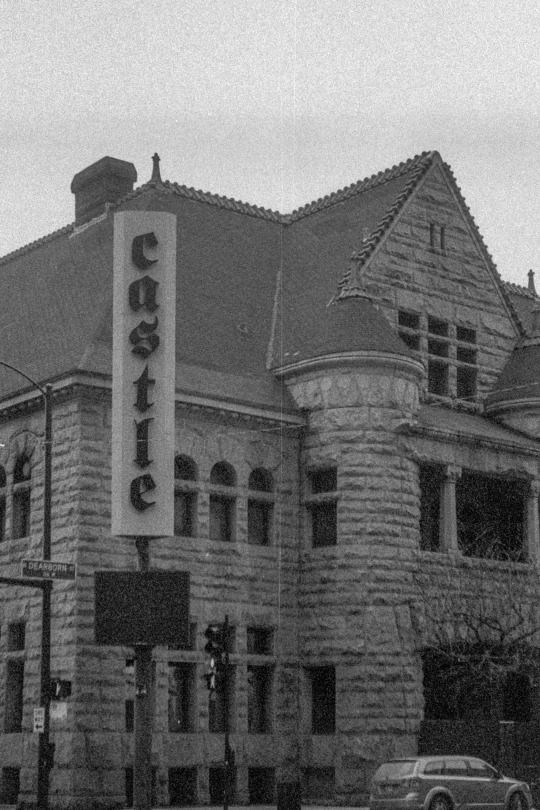
Having borrowed the Argus, I began the immersion process, surrounding myself with wikis and manuals. Made from 1939 till 1966 by Argus in Ann Arbor, Michigan. The camera was surprisingly entry level, designed in the late 30's. Saw use by photojournalists during WWII, even managed to snap some iconic shots from the front lines. In the later years it saw widespread use in many American homes, its affordability, ruggedness and repairability fueling its popularity. Even Jimmy Carter had one. But with the flood of inexpensive Japanese SLRs in the 60's, the archaic rangefinder design of the C3 phased it out into obscurity.

The Brick (as it was affectionately known) had a coupled rangefinder mechanism with a separate viewfinder. Focusing had to be done in one window, framing in another. Both finder windows were some of the smallest I've encountered - even smaller than in my Olympus Stylus Epic - which didn't lend to usability. The leaf shutter speeds went from 1/300 to 1/10 and included provisions for cable release and bulb. Winding the film was manual and separate from winding the shutter. The lens is, surprisingly, interchangeable, but required tools and minutes to change and an external finder for any other focal length than 50. The bare essentials were there, but literally nothing else.

This skeleton crew of camera functions was a contributing factor to its simplicity and ruggedness. The camera proved incredibly easy to disassemble and work on. The original lubrication had half-evaporated and half-turned-to-stone, but that was quickly remedied with a fresh coating. Play had developed over time in the gears, knobs and dials giving that bucket-full-of-bolts effect - but everything was tightened to spec with simple garden variety screwdrivers and wrenches. Very easy to see why the camera continues to work well even 61 years after it rolled off the production line - inside was a date stamped indicating a 1955 production year.
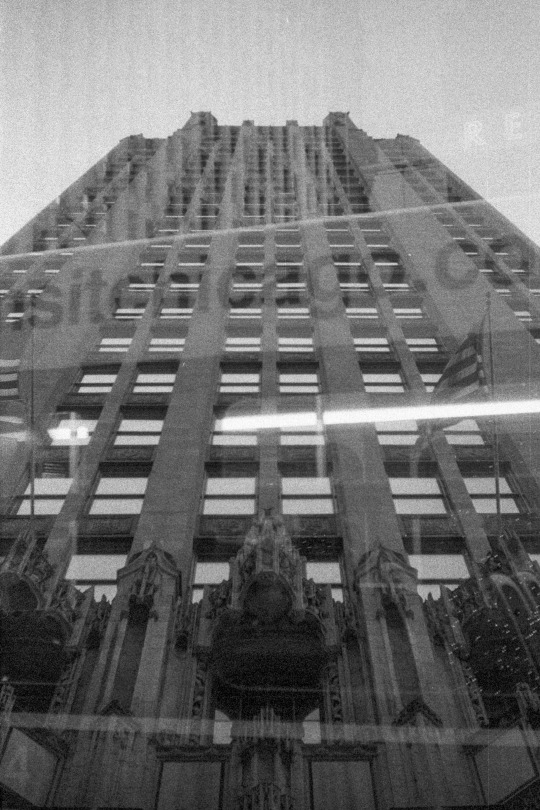
After everything was put together, the kid-on-Christmas-Eve syndrome took over and the decision was made to test the camera next day. Weather conditions were highly unfavorable for testing out an all-metal, f/3.5, all-manual camera from 1955. Nearly sub-zero (that's in Fahrenheit, folks) temps, hours of traffic and inches of snow separated us from our intended destination of Downtown Chicago. Mercury was dropping faster than the sun on the horizon as I hoped I could still feel the unfamiliar controls of the C3 through my thick winter gloves. Film of choice was Ilford Delta 3200, rated at 1600 to keep the grain from consuming the image. Original choice was Kodak Tri-X 400 to keep the entire package in the same era, but the mailman failed to deliver forcing the switch, which actually allowed me to shoot for much longer because the light got sucked out pretty quick with all the extra snow in the air.

The destination was chosen simply because there is no better fit to the form and function of this photographic relic and its place in history than Chicago's own iconic architecture, with its arcane pillars of weathered steel and iron, chiseled art-deco-esque bastions of concrete and slabs of modernist lines receding into infinity. Chicago's facade went through many styles and movements, fueled by advances in construction technology and architectural sciences. But its roots are still bare for the eye to see with the future layered over it. Much of the same applies to the C3.
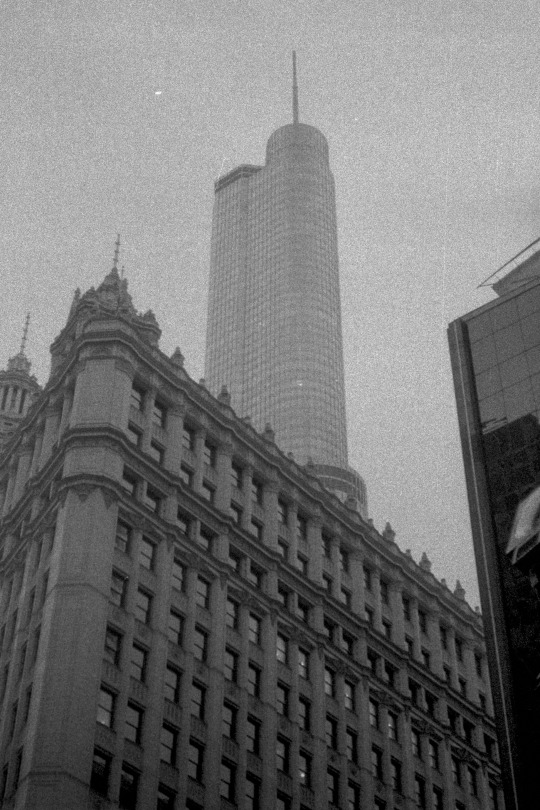
I was joined on this trip by lovely fellow 43S-member Kris (wo)manning the A and B cams for our video review of the trip. Dodging snowflakes, she kept the video rolling while I was busy keeping a mental checklist of the 10+ steps I had to do before taking a single shot on the Argus. Plan was to try to score shots that would reveal the gritty limestone-laden angles of a city that originally inspired Batman's mobster-mastertown of Gotham. Segue through to Ohio Street to Michigan Avenue, make our way down to the Riverwalk and continue clicking all along Wacker Drive. Sneak peaks of the Water Tower, John Hancock, NBC and Tribune towers, as well as the transformers building (35 E. Wacker Dr.) and Merchandise Mart - all were on the snowed-over map that was increasingly harder to follow.

One of the reasons I like using medium format cameras is because you have less frames to worry about, allowing you to focus more on quality, than quantity. All of a sudden having 36 shots to work with sometimes feels like a burden on short, one-day trips. I actually found that fact comforting the first time using a new old camera, resurrected from the dead. Which leads me to mention some of the things I disliked while using it - first of which is ergonomics. Or rather lack of them. It takes very little time to figure out that this camera is not going to be comfortable to hold. Ironically it takes much longer to figure out how to hold the darn little brick in such a way as to not cover up any viewports or get the shutter finger jammed in the way of the shutter cock/release lever. When the shutter button is actuated, the cocking lever springs back, and if the finger is in the way, you get a very, very long exposure (if you know what I mean). At least some shots fell prey to this malice. The other biggest gripe I had with this camera is that everything is manual and separate, including the frame advance winder. Accustomed to using mainly 60s Japanese SLRs and up, where the shutter cock and frame advance are all in one lever - here it's actually three(!) separate mechanisms. One for the shutter cock, one for the frame wind, and one safety latch to allow the frame winder to wind. While probably the stuff of pink fluffy dreams for fans of multiple exposure photography, I was actually quite enfuriated at having to remember to do so much to accomplish something so simple - leading to multiple shots being overlayed one atop another. Did I also mention that I wasn't a fan of the brick-like shape and ergos? I did? Good, I'll mention it again, because it really is not made for human hands. Maybe for robot hands...
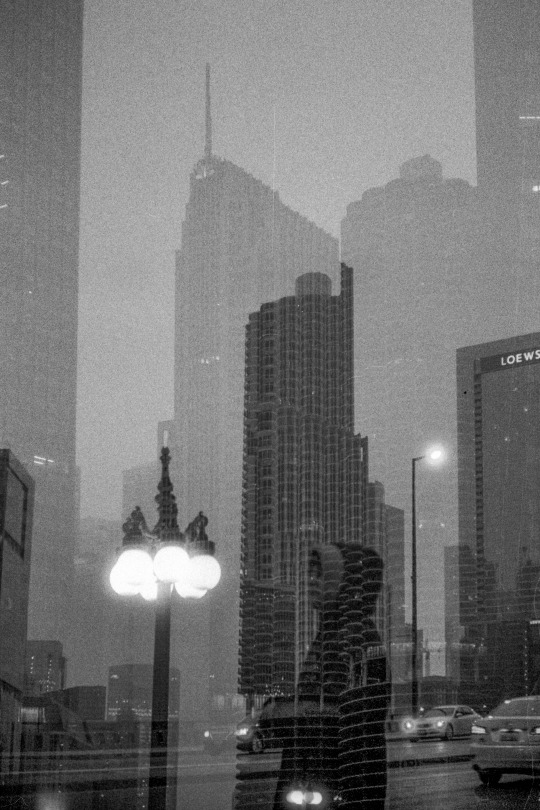
But it wouldn't be a proper camera review without mentioning some of the positives of this fully mechanical monster. And there are quite a few. Surprisingly they have more to do more with its flaws than anything else. The main reason I picked it up is because I really wanted to create some imagery that looked like it came from another time period. Anachronism is the name of the game for me when I use vintage gear and the included 50mm lens delivers in spades giving you that vintage "look". Supposedly coated, the effect is thankfully nowhere to be seen, with images full of silky-smooth, flat-as-LOG gradations of gray almost completely devoid of contrast. Due to a short focal flange distance the lens is surprisingly sharp in the center with minimal distortion, while its antiquated optical formula contributes copius amounts of vignetting that's present even when stopped down. All combined, makes shots look like newsreel footage from the past. Second positive is that just like any film camera, this one slows you down and lets you think more about the content. But where other film cameras are more of a moderately mindful experience, this one is hands-down almost ritualistic in the way it forces you to adhere to the craft. Almost nothing short of actually picking up an old 8x10 - complete with bellows, dark slide, curtain, ground glass and all - can compare. And third is, of course, the conversation starter effect. Just that day alone, three people approached me interested to find out more about the camera. Just not that many crazies like us out there any more, I guess...
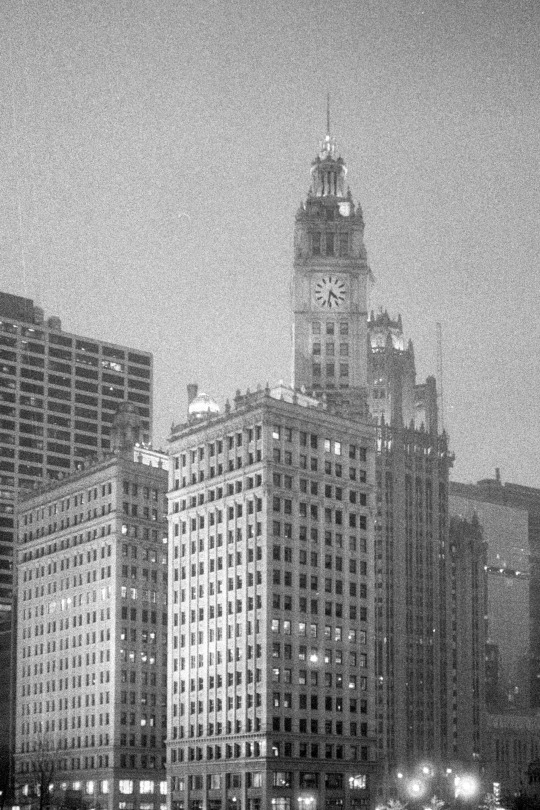
All in all it was a wonderful experience, will be a sad day when I have to return the camera back to my friend. The Argus C3 is a great camera for very niche and very vintage-looking photos. Just treat the cons as pros and embrace the craft. Already looking forward to my next vintage camera to try out - have an old 4x5 from the 30's which I still have yet to fix...
PS: ending the review with a little poster I designed commemorating the trip ;)


#film#analog#photography#35mm#argus#c3#50mm#camera#test#review#vintage#black and white#bw#ilford#delta 3200 professional
1 note
·
View note
Text
Lord Of The Rings & Christianity - Old Work
The Lord of the Rings is a film trilogy that has Christ-like symbolism all throughout. The author of the trilogy, J.R.R Tolkien was a Christian himself, so it makes sense that references to Christianity could be seen once it was adapted for the big screen.
In my opinion there are many characters that can exemplify different aspects of the life of Christ. One such character would be Samwise Gamgee, the “side-kick” character who helps Frodo Baggins on his journey to destroy the “One Ring”. He is there for Frodo no matter what, through the good times and the bad, and is the person that helps Frodo to stay strong. He has one quote in which he says to Frodo “I can’t carry it for you but I can carry you” in reference to the ring. Samwise won’t carry the ring itself because he won’t put himself near the temptation, he resists and does not fall prey to it like so many other characters do. The ring represents Frodo’s burden that he has to bear, similar to the burdens we have to carry throughout life. This is similar to a Christian’s walk with God. God doesn’t always make our problems disappear and take them all upon himself to fix. Often times he is there to help us through. He “carries us” as we work through our problems.
Samwise also refuses to leave Frodo, despite Frodo’s attempts to go on without the gardener. He tries to leave on a boat but Sam will not have it and he chases after Frodo, regardless of the fact that he doesn’t know how to swim. This is similar to the verse in the Bible in Deuteronomy 31:6 that says, "Be strong and courageous, do not be afraid or tremble at them, for the Lord your God is the one who goes with you. He will not fail you or forsake you." God would never leave us, despite if we try to leave him, and the same goes for Sam with Frodo.
Sam seems to suffer alongside Frodo, he feels his pain and goes through it all with him. His heart breaks when Frodo’s does and he never allows Frodo to feel alone. This is similar to the idea of a suffering God. Christians believe that God feels our pain and sympathizes with us. When we grieve, he grieves. He is in tune with us and our emotions and wants the best for his people.
Gandalf portrays a specific aspect of Jesus’s persona as well. Throughout all of his journeys, he is gathering people to help in the fight for good. This is similar to how Jesus gathered his disciples to help spread the word of God. Gandalf also sacrifices himself for his friends when he battles the Balrog, putting himself between the beast and his comrades. He sacrifices himself so that the others can escape and continue on their task. Jesus’s crucifixion can be compared to this as they both laid down their life for others. In John 15:13 in the Bible it is said that “Greater love hath no man than this, that a man lay down his life for his friend”. This can be seen in both Gandalf and Jesus as they sacrifice themselves so that others may live. Gandalf in the sense that his friends can continue on in their mission, and Jesus in the sense that we can now have eternal life in heaven because of his death on the cross.
However, similar to Jesus, Gandalf does not remain dead. No, he returns as Gandalf the White and continues on to help in the battle for good. This is reminiscent of the resurrection of Jesus Christ. Jesus returns and brings back hope to the world. Gandalf does the same for Middle Earth.
Another aspect of Christ is evident in the character of Aragorn. He is the true king, however, the first time we see him on screen he doesn’t look like the typical king we think of. He isn’t wearing a crown covered with jewels but a dark colored hood with an almost dirty appearance. In Jesus’s time, people doubted that he was the true king because of how he appeared. He arrived to the world as a baby and became a carpenter’s son. He didn’t come on a horse with an army. He wasn’t commanding or demanding. He was a simple, humble man who lived his life the way a good person should. However, none of this changed who he truly was, the son of God.
Appearance wise, Aragorn looks similar to typical depictions of Jesus. He has the beard and medium length dark hair that is absolutely reminiscent of the styles that is believed for men to have worn back during Jesus’s times. I do not know whether this was done on purpose or not, however, if so, it was a great choice for his character. It’s a subtle nod to Jesus that believers would be able to pick out.
Aragorn also goes out of his way to protect the Hobbits, just like God protects his children. The Hobbits as a whole represent a childlike faith. In Mark 10:13-16 it states “And they were bringing children to him that he might touch them, and the disciples rebuked them. But when Jesus saw it, he was indignant and said to them, “Let the children come to me; do not hinder them, for to such belongs the kingdom of God. Truly, I say to you, whoever does not receive the kingdom of God like a child shall not enter it.” And he took them in his arms and blessed them, laying his hands on them.” That being said, I think it is important to note that the person chosen with the job of carrying the ring (as well as three of his companions) was a childlike character. Hobbits are small like children, youthful looking, energetic and exuberant. Merry and Pippin even more so exemplify childlike behavior with their songs and dances and mischief that they get into. However, they are also characters that help turn pinnacle moments in the story, such as Merry in battle, or Pippin’s warning that Faramir was still alive when he was about to be burned. They may seem small but they can do mighty things. As Balin the dwarf says in The Hobbit film, “It never ceases to amaze me: the courage of Hobbits”. Personally, I believe that the same could be said for children. They are more resilient than people think and shouldn’t be underestimated.
Apart from Frodo, there is also a “company” who travels with him in order to complete the job of getting the room to Mount Doom. This group includes Frodo, of course, Samwise, Gandalf, Legolas, Gimli, Aragorn, Boromir, Merry, and Pippin. They are from all different groups and classes, similar to how Jesus picked different types of people to be his disciples. They help out in the fight for good and aid Frodo in achieving his goal.
Uncharacteristically for his time, Jesus also included women in his teachings and his group of followers. He brought about the idea that men and women could be portrayed on equal footing. In The Lord of the Rings, Éowyn is an example of this. She shows how women are in fact equal to men by taking up her sword and charging into battle, killing an adversary that no man had been able to. In fact she said in response to “no man can kill me” by saying “I am no man”.
A blatant representation of the antithesis of the Jesus Christ way of life is the temptation that many characters go through as a result of coming close to the Ring. Some characters let the ring take full control over them, such as Gollum who at one point was a normal looking Hobbit-like creature, but became a decrepit shell of his former self. This symbolizes both how sin can eat away at you until you are virtually unrecognizable as the person you used to be and life without Christ. However, temptation can also be more subtle, such as the times Frodo uses the ring, despite being warned not to use it. He sees it as almost an easy way out of difficult and sometimes dangerous situations. It seems harmless at the time, and even helpful, however, he doesn’t realize the toll that using the ring will take on his psyche. This is similar to “little sins” or “white lies” that we go through in life, things that Christianity warns us of as the little things can pile up over time until they can snowball and we get stuck in a web that we can’t get out of.
Another example of the antithesis of Christ would come in the form of Saruman. He’s deceitful. He is what I refer to as “evil in a pretty package”. At first, he looks like he is doing good. He’s all dressed in white, putting off an air of purity when in fact he is anything but. Gandalf, who is supposed to be so incredibly wise, is even tricked by Saruman. In Matthew 24:24 it says “For false Christs and false prophets will arise and will show great signs and wonders, so as to mislead, if possible, even the elect.” Gandalf was blinded by the fact that Saruman was supposed to be his friend that he couldn’t discern the evil that Saruman possessed.
Who is Jesus? To me, Jesus is a friend. While being divine, I also see him for who he was as a human as I find that side of him easiest to relate to as I am obviously a human myself. I can see how he lived and apply it to myself as a means of guidelines on how to live my own life. I feel like regardless of your perspective on religion, you can take his way of life and apply it to your own. Such as how he treated others, not being judgemental, being caring and going out of his way to help people, as well as many other positive traits. Jesus is someone I can look to as a positive example whose lifestyle can still apply in modern day. He’s a much better role model than those that people consider role models today and more people should look to him for how to live their lives.
0 notes